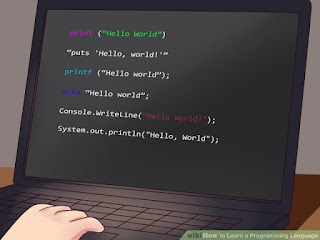Basic of a Computer Programming Language
Computer programming has its own language, and that’s just
the beginning of the software adventure. There are many different languages in
computer programming, and all of them have their own purposes. In order to
understand the importance of computer programming languages, knowing them, and
tweaking them, one has to understand the importance of computer programming.
Computer programming produces software packages, among other things, to meet
our needs. We may need software for accounting, making photos bigger or
smaller, or editing our home videos. Behind all these software packages are the
computer programmers who use their individual languages in order to create the
software.
One such computer programming language is the Beginner’s
All-Purpose Symbolic Instruction Code, or BASIC. BASIC is actually composed of
many different kinds of programming languages that are actually higher level
than most other languages. This BASIC family of computer programming languages
was first designed in the 1960’s, and was originally made for non-science
people to gain better access to computers. During that time, using a computer
required that a person write customized software, a task that only
mathematicians and scientists were equipped to do. The BASIC language was
therefore a bridge for people of other professions to take advantage of the
power of computers.
When the 1970’s came, the BASIC language, whether in its
original form or a variant of it, spread onto microcomputers; and by the
1980’s, even home computers could be run in BASIC. Today, BASIC remains
popular, as it serves as the basis for many of the more modern programming
languages that have been developed in the wake of advanced operating systems
and the Internet.
When it was originally conceived, BASIC was meant for
beginners: it was a language that people could use easily, whether or not they
were educated in mathematics and the sciences. The language also had to be a
general purpose one, in that it had to serve many different needs, and not only
those that mathematicians and scientists required. The root language of BASIC
also had to allow for advanced features to be plugged on as experts grew more
and more adept in it, and as the language found further use in many other
fields. BASIC was also meant to be interactive, and was designed to show error
messages that were clear and friendly; that is, these error messages had to
completely explain what the problem was, which would hopefully allow the user
to fix it faster and easier.
When it was first released, moreover, BASIC was free of
charge, which allowed the language to spread much faster. Once the language
spread much faster, it was also easy to modify it and correct errors. BASIC was
also distributed to a few high schools in order to promote it faster. Thanks to
this widespread use of the language, BASIC was soon implemented on several
microcomputers, and by several software manufacturers.
Despite its success, BASIC has had its dissenters. For
instance, some programmers find that its scripts do not show proper programming
practices, and the language itself is too slow, or sometimes even too simple.
Despite all these, however, BASIC has continued to thrive, succeed, and evolve,
and has thus become a good tool to introduce beginner programmers to the
concept of coding and computer programming.
These are only a few facts about the BASIC language. For
more information on BASIC, read and do your own research through several key
pages online, or using computer programming books.



